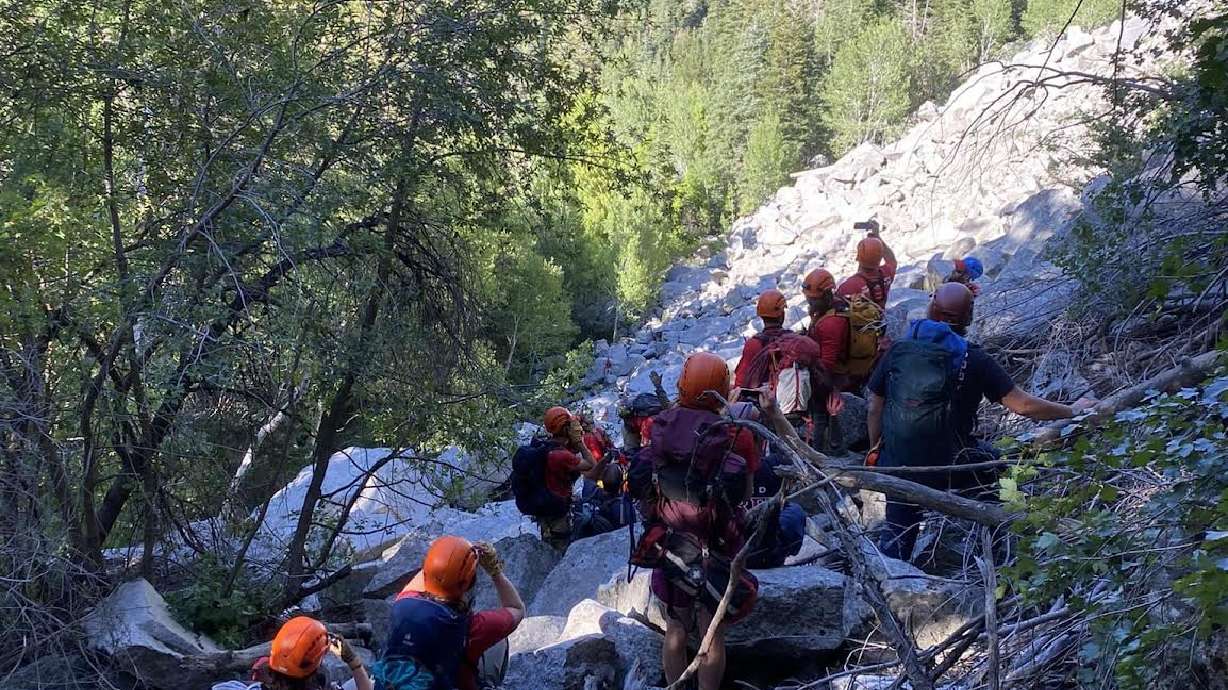Estimated read time: 4-5 minutes
This archived news story is available only for your personal, non-commercial use. Information in the story may be outdated or superseded by additional information. Reading or replaying the story in its archived form does not constitute a republication of the story.
SALT LAKE CITY — Search-and-rescue teams have conducted multiple missions this month as temperatures continue to rise and hikers continue to seek cooler temperatures.
Salt Lake County Search and Rescue reported four recent incidents, with one on Saturday. At about 1:56 p.m., dispatchers received a call regarding a family of three seeking help while on a hike near 880 N. Ensign Vista Drive, in Salt Lake City.
The mother, father and child had run out of water during their hike and could not continue due to exhaustion, according to Salt Lake City Fire Capt. Chad Jepperson. The heavy rescue team responded, along with a medical helicopter. The helicopter was able to transport the family to a command post further down the mountain to receive care.

The family was provided with water and was released at the scene, said Jepperson.
Another similar rescue on Thursday involved an injured climber on the Pentapitch climbing route in Little Cottonwood Canyon. The climber took a lead fall on the fourth or fifth pitch, breaking his lower leg bones. The injured climber's partner immediately lowered him and nearby climbers assisted by helping splint the injured leg.
Several rescuers responded at the base where the climber had been lowered and along the trail. Paramedics were also dispatched to treat the injury and provide pain management. The Utah State Department of Public Safety Aero Bureau hoisted the climber from the location to a waiting ambulance.
On Tuesday, rescuers responded to an injured hiker at Brighton Ski Resort. A group of three women were hiking in the Mt. Millicent area when one of the hikers rolled her ankle, resulting in a sprain or possible break. Unified Fire Authority paramedics were dispatched to the scene where they treated the injury. The rescue team then took the patient from the steep location to a waiting side-by-side ATV.
On July 7, search and rescue teams were dispatched to assist a lost hiker near the summit of Mount Olympus. After summiting, the hiker mistakenly descended into upper Hughes Canyon, where they soon realized the mistake and contacted search and rescue for help.
Search-and-rescue teams were able to use technology to determine the hiker's location. A team was dispatched to the location where they "bushwhacked a few hundred feet downhill to the waiting patient," according to a Facebook post. The teams and hiker reversed course and hiked to the trailhead and two more teams were deployed to carry packs full of water and electrolytes up the mountain.

The two teams staged the liquids at various locations along the trail and "other hikers with questionable hiking plans were consequently supplied with water and Sportdrink," the post added.
- Let someone know where you are going and when you expect to return.
- Know before you go. Learn about the local weather conditions and conditions of the terrain. Know how to use your emergency gear.
- Know your limitations and when to postpone your trip. Turn back if the weather is changing, the terrain is too strenuous, or the river is too high, etc.
- Stay together. Lone hikers are more likely to need rescuing.
- Pack in and pack out what you take into the backcountry.
- While cell phones can be helpful, be aware that cell phone coverage can be sporadic, at best, in the backcountry.
- If you need rescue, don't be a moving target. Shelter in place, whether that's near a trail, a body of water, your disabled vehicle, etc. If you are lost, the most important thing to do is to not panic but to S.T.O.P. (Sit, Think, Observe and Plan).
- If on the water, make sure you have enough Personal Flotation Devices for each person in the boat or raft. Adults and youth in your canoe or raft should know how to self-rescue in the event the watercraft capsizes. Unskilled swimmers should wear a PFD at all times.
- Carry the appropriate gear and be prepared for emergencies. When choosing your gear, remember that the body's ability to maintain its core temperature is essential to survival, and pack accordingly.
- Know how to contact the local sheriff's office in an emergency.









